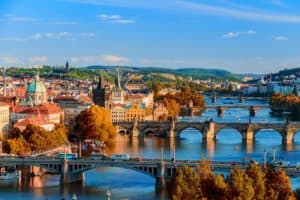Uncovering the Galician Language: A Journey Through its History, Features, and Influence!

Updated On: May 13, 2024 by Esraa Mahmoud
The Galician language, a vibrant melody echoing across northwestern Spain, is more than just a means of communication; it’s a cultural cornerstone, a bridge to a rich Celtic past, and a testament to the enduring spirit of a people. Often overshadowed by its more prominent cousin, Castilian Spanish, Galician boasts a unique history, a distinct vocabulary, and a literary tradition that continues to flourish.
As we delve into the world of Galician, we embark on a journey that stretches back centuries. Its roots lie in the Gallaecian Latin spoken by the Romans who conquered the Iberian Peninsula. Over time, this Latin evolved, absorbing influences from Germanic languages and the Suevic people who settled in the region. The result? A distinct Romance language, separate from Castilian Spanish, with its own melodic intonations and captivating vocabulary.
Exploring the Galician language is more than learning a new set of words. It’s about delving into a unique cultural heritage, appreciating the enduring spirit of a people, and experiencing the beauty of a language that has weathered centuries of change. So, let us embark on this captivating journey and discover the melody of the Galician language.
The Galician Language: History, Features, and Influence
The Galician language’s rich history and unique features have greatly influenced the region’s culture and identity.
Origin and Classification
Unlike its dominant neighbour, Castilian Spanish, Galician’s roots lie not in Vulgar Latin brought by Roman soldiers but in the Gallaecian Latin spoken by settlers who arrived centuries earlier. Over time, this Latin dialect evolved, absorbing influences from the languages of various groups who inhabited the region, including the Suevi, a Germanic tribe. The result? A distinct Romance language, separate from Castilian Spanish, with its own melodic intonations and captivating vocabulary.
This classification within the Romance language family places Galician in esteemed company. Like French, Italian, and Romanian, it shares a common ancestor in Vulgar Latin, yet each language has carved its own unique path through the centuries. This kinship is particularly evident when comparing Galician to Portuguese, its closest linguistic relative. Many words share a remarkable similarity in both sound and appearance, a testament to their shared Iberian Peninsula heritage. Imagine encountering a sentence in Galician and strikingly resembling its Portuguese counterpart – a linguistic echo across borders, hinting at a common ancestry.
However, despite the undeniable similarities, Galician and Portuguese are distinct languages. Centuries of political and cultural divergence have resulted in vocabulary, pronunciation, and grammar differences. Understanding these nuances is crucial for appreciating the unique character of the Galician language.
Exploring the origins and relatives of Galician isn’t just about linguistic classification; it’s about understanding the historical forces that shaped this vibrant language. By tracing its roots back to Roman settlers and Suevic tribes, we gain a deeper appreciation for the rich tapestry of influences that continue to resonate in Galician today. By acknowledging its close kinship with the Portuguese, we celebrate the enduring linguistic legacy of the Iberian Peninsula.
Diglossia and Influence of Spanish

The Galician language exists in a fascinating yet precarious situation known as diglossia. Imagine a world where two languages coexist, each with its designated domain. In Galicia, Spanish reigns supreme in formal settings – education, government, and media. However, within the warm embrace of homes and amongst friends, the melodic tones of Galician take centre stage.
This linguistic duality has undoubtedly impacted Galician. The dominant presence of Spanish has led to the adoption of some vocabulary and grammatical structures, blurring the lines between the two languages. Imagine a sentence where a Spanish verb seamlessly blends with a Galician noun, a testament to the constant interaction between the two.
However, this isn’t a story of inevitable decline. A growing awareness of the importance of preserving Galician’s unique identity has sparked a cultural revival. Initiatives promoting the use of Galician in schools and media are underway, ensuring younger generations can inherit this precious linguistic legacy. Furthermore, Galician literature and music continue to flourish, offering vibrant expressions of cultural identity in the face of a dominant language.
The future of Galician remains to be written. The influence of Spanish is undeniable, a constant reminder of the challenges inherent in diglossia. However, the resilience of the Galician people and their growing commitment to preserving their language offer a glimmer of hope. The Galician language, far from being a relic of the past, is a living testament to the enduring power of cultural identity and the enduring beauty of a language that refuses to be silenced.
Rexurdimento (Renaissance)
The 19th century witnessed a captivating revival in northwestern Spain: the Rexurdimento, or “Galician Renaissance.” This period wasn’t just a flourish of artistic expression but a deliberate and passionate movement to restore pride in Galician culture and language.
For centuries, Galician had been relegated to the shadows, overshadowed by the dominant Castilian Spanish. The Rexurdimento sought to change that narrative. Fueled by a renewed interest in their Celtic roots and a yearning to celebrate their unique identity, Galician intellectuals, writers, and artists embarked on a mission to revive their language.
This movement wasn’t merely about resurrecting dusty manuscripts. It was about breathing new life into the very soul of Galicia. Writers such as Rosalia de Castro and Eduardo Pondal emerged as voices of a generation, crafting literary works that celebrated Galician history, folklore, and the lyrical beauty of the language itself. Their poems and novels weren’t just stories but declarations of Galician identity, testaments to a culture that refused to be silenced.
The impact of the Rexurdimento was profound. It fostered a sense of pride among Galicians and established Galician as a language worthy of literary expression. This cultural awakening played a crucial role in preserving and revitalising the language, ensuring its survival for future generations.
Today, the legacy of the Rexurdimento lives on. The Galician language enjoys official recognition, and a vibrant literary and artistic scene thrives. As we explore the rich tapestry of Galician culture, we acknowledge the pivotal role played by the 19th-century revival. The Rexurdimento wasn’t just a historical footnote; it was the spark that rekindled the flame of Galician identity, ensuring its enduring legacy in the modern world.
Geographic Distribution and Legal Status

The Galician language isn’t confined to dusty tomes or museum exhibits; it’s a living, breathing entity that thrives in the northwestern corner of Spain within the autonomous region of Galicia. Here, amidst rolling hills and a rugged coastline, Galician serves as the primary language for roughly 3 million people, their voices weaving a tapestry of sound that echoes through the ages.
However, Galicia isn’t the sole domain of this captivating language. Communities of Galician speakers can be found scattered throughout Spain, remnants of historical migrations and cultural exchange. Imagine pockets of Galician speakers in Asturias, León, Zamora, and even Extremadura, their voices carrying the melody of their heritage across regional borders. These communities, though smaller, serve as vital links to the past, reminding us of the language’s historical reach.
Beyond the Iberian Peninsula, the spirit of Galician extends even further. Due to historical diaspora and immigration patterns, pockets of Galician speakers can be found in Argentina, Uruguay, Cuba, and even Brazil. Though geographically distant, these communities hold onto the language as a precious link to their ancestral home.
The legal status of Galician reflects its importance. Within Galicia, it enjoys official recognition alongside Spanish, a testament to the region’s commitment to preserving its cultural heritage. This official status ensures the use of Galician in education, administration, and media, fostering its continued growth and development.
Exploring the geographic distribution of Galician is more than just mapping locations on a page. It’s about recognising the enduring spirit of a language and its ability to transcend borders and connect communities across vast distances. From the heart of Galicia to far-flung corners of the world, the Galician language continues to resonate, a vibrant melody echoing its rich history and enduring cultural significance.
Features and Influence of Galician Language
The Galician language has unique phonology, grammar, and dialects, contributing to its rich linguistic diversity. Its close relationship with the Portuguese also plays a significant role in shaping Galician culture and identity.
Phonology and Grammar
The phonology and grammar of the Galician language play a crucial role in its distinctiveness. Galician has 23 consonants and seven vowels, with some variations across different dialects. The pronunciation can vary depending on the region, but it maintains a melodic quality similar to other Romance languages.
In terms of grammar, Galician follows a subject-verb-object word order like English. Nouns have gender (masculine or feminine) and number (singular or plural), and adjectives agree with the nouns they modify. Verbs are conjugated based on tense, mood, aspect, and person.
While there may be similarities between Galician and Portuguese due to their shared history as closely related languages, each language has its unique characteristics. It’s important to note that despite being influenced by Spanish over time, Galician retains its own identity and continues to evolve as an essential part of Galician culture.
Dialects
Galician, like many other languages, has different dialects. These variations occur because Galicia has diverse geographical features and historical influences. The main dialects of Galician are named after the areas in which they are spoken: Fala, Mariñeiro, Central, and Baixo-Miño.
Each dialect has its own unique characteristics in terms of pronunciation, vocabulary, and grammar. For example, the Fala dialect is influenced by Leonese and Asturian languages, while the Baixo-Miño dialect shows some influence from Portuguese.
Despite these differences, all Galician speakers can easily understand each other. It’s fascinating to explore how these dialects reflect the rich linguistic diversity within Galicia!
Use and Preservation
There are ongoing efforts to ensure its vitality and survival when it comes to the use and preservation of the Galician language. Many people in Galicia, especially those proud of their cultural heritage, actively speak and promote using Galician in various contexts.
This includes education, media, literature, and even official government communication. Additionally, organisations are dedicated to preserving the language through initiatives such as language courses and workshops.
Relationship with Portuguese
The Galician language has a close relationship with Portuguese. Both languages belong to the same Romance language family and share many similarities in phonology, grammar, and vocabulary.
In fact, historically, Galician was closely related to Portuguese and was even considered a dialect of it. However, over time, Galician has been influenced by Castilian Spanish due to political and cultural factors.
Despite these influences, the connection between Galician and Portuguese is still evident today, making it easier for speakers of one language to understand the other. This linguistic relationship also reflects the historical ties between Galicia and Portugal as neighbouring regions on the Iberian Peninsula.
Impact on Galician Culture and Identity
The Galician language plays a significant role in the culture and identity of the Galician people. It is seen as an essential part of who they are, connecting the people to their history and heritage. Through the language, they express their unique Galician identity and preserve their cultural traditions.
Galician literature, for example, has a rich heritage that dates back centuries. Many renowned poets, writers, and playwrights have used the Galician language as a medium to explore themes specific to the region’s history and landscape.
This literature helps shape the people’s cultural identity by showcasing the beauty of their language and fostering pride in being Galician.
Furthermore, preserving the Galician language contributes to linguistic diversity not only in Spain but also within the wider context of Romance languages. The language is part of the Ibero-Romance family and shares similarities with Portuguese.
In conclusion, exploring the Galician language takes us on a fascinating journey through its rich history, unique features, and enduring influence. From its Celtic roots to its close relationship with Portuguese and its impact on Galician culture and identity, Galician is a linguistic treasure that deserves to be celebrated and preserved.






